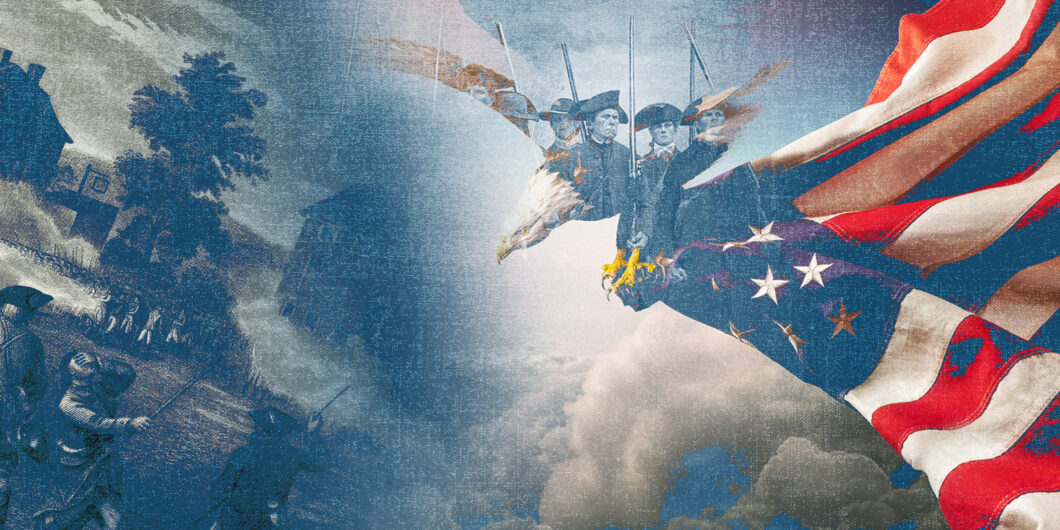Do we want a UK where every citizen gets his daily bread from the state?
On the Hinge of History
While the combatants’ blood surely boiled when the first shot rang out in the misty dawn on Lexington Green, almost exactly 250 years ago, many also likely felt a disbelief, if not horror, that things had come to this pass. It must have seemed to most on both sides that, in ways large and small, the descent into what was a civil war was not foreordained and could have been avoided with but some luck and wisdom.
On the semiquincentennial of the outbreak of the War of Independence, we read back to 1775 and the subsequent years of the Revolution as all but fated to occur, given the stubbornness of King George III, the lack of imagination of Lord North and his ministry, the hotheadedness of radicals like Samuel Adams, and the broad-based anger of colonists, especially in the obstreperous and oppressed Province of Massachusetts Bay.
Building on literally centuries of scholarship, Richard Ryerson’s compelling essay on Lexington and Concord asks three critical questions: 1) how did so many colonists come to believe they had a right to armed rebellion; 2) why did these convictions become stronger in Massachusetts than in any other colony; and 3) why did so many colonists become convinced they could rebel successfully?
Ryerson convincingly sketches how a constitutional crisis became an armed conflict, infused by a revolutionary change in the ideology held by many colonists and their leaders, as explored by Bernard Bailyn nearly 60 years ago in his magisterial Ideological Origins of the American Revolution. The broader milieu that Ryerson traces in his essay has been most recently explored by Rick Atkinson, in the first volume of his trilogy on the Revolution, The British Are Coming.
Thousands of books on the Revolution should make anyone wary of questioning long-accepted interpretations of Britain’s missteps, American passion and luck, and the geopolitics that brought France and Spain into the conflict not as much in support of the Americans as in opposition to their hereditary enemy Great Britain. All serious students of the Revolution, of course, acknowledge that any number of events could have gone differently, and all are aware of contingency in history.
And yet the 250th anniversary offers us perhaps a unique moment to recreate a sympathy with those days, not pretending that we can ever understand exactly how the major actors thought (despite the copious evidence they left behind) or using hindsight to understand why things happened as they did, but to put ourselves back in the same frame, so to speak, as were most colonists: worried and interested onlookers, trying to make sense of events seemingly taking on a life of their own. Reviewing some of these points where contingency seems particularly potent is not an exercise in counterfactual history, but doing so may at least make us sensitive again to the uncertainty of those days and to an appreciation of how history may have unrolled in a different direction.
While Ryerson focuses on the path by which colonists, especially those in Massachusetts, evolved a mindset that both justified rebellion and strengthened their optimism that they could win, it is of course a well-known fact that support for a revolution was far from widespread. Decades after the events, John Adams wrote that only one-third of Americans had supported war with Great Britain, with another third—mostly Loyalists—opposed, and a middle third undecided. Various colonial assemblies had sent delegations to the Second Continental Congress that were opposed to or skeptical of separating from King and Parliament. Among these, Pennsylvania, New York, and South Carolina stand out, and even as late as May 1776, the colonies were split eight to five in favor of voting for independence.
The idea of ending the only real world the colonists had known, as a part of Britain, was indeed an overwhelming one. Ryerson rightly points out that Massachusetts was different from many of the other colonies, due to its long tradition of autonomy as well as the punishing effects of the Intolerable Acts imposed after the Boston Tea Party of December 1773—all of which made Massachusetts far riper ground for rebellion than most of the other colonies. British actions against Massachusetts bolstered radicals in other colonies, but voices urging caution were just as prominent, and it was not unreasonable to think they might have swung the pendulum away from the confrontation that Massachusetts sometimes seemed to invite.
At those very moments when the hinge of history was swinging, any number of possible differences, even minor ones, might have provided the breathing space for an alternate unfolding of events. Some seem almost irrelevant, such as the possibility that if the British ship Falcon, which brought the official orders to General Thomas Gage in Boston in April 1775 to crack down on the rebellious colonists, had been becalmed for a few more weeks, then Gage would not have sent out troops to confiscate the arms and materiel hidden in Concord on the night of April 18; how and when he would later have done so could have led to a different outcome than the slaughter of that day. Or, if Major General Francis Smith’s troops were better disciplined and hadn’t unleashed their volley on the Green when an errant shot rang out. Or, if Gage had followed more precisely his instructions from London, to hunt down and capture the Massachusetts ringleaders, like John Hancock, instead of precipitating a face-off with Lexington and Concord Minutemen by marching in force to seize the armaments, hostilities may have been delayed and not erupted in the way they did. With so many colonists wary of conflict with Britain, such small things might well have led to a different path than the one followed.
In the uncertain days of April 1775, one can well imagine even proud “Americans” hoping that somehow, the approaching storm clouds would dissipate.
Even after armed conflict erupted at Lexington and Concord, there was a powerful movement to end hostilities as quickly as possible, long before Independence became a preferred option. On July 5, 1775, the Second Continental Congress sent to King George the so-called “Olive Branch” petition, placing blame on the King’s ministers and ensuring the monarch that the colonists “most ardently desire the former harmony between [Great Britain] and these colonies may be restored.”
The following day, July 6, 1775, Congress issued a “Declaration of the Causes and Necessity of Taking Up Arms,” written by Virginia’s Thomas Jefferson and Pennsylvania’s John Dickinson. While insisting that they were fighting only “in defence of the freedom that is our birthright,” the colonists also tried to reassure the English that they sought no radical change in imperial ties, asserting, “We have not raised armies with ambitious designs of separating from Great-Britain, and establishing independent states.”
These entreaties were ignored by the King and Parliament, foreclosing the chance of ending the war at an early point. But, of course, the history of the decade from 1765 to 1775, from the imposition of the Stamp Act to Lexington and Concord, was one of repeated missteps, overreaction, precipitous withdrawal, and above all, poverty of imagination on the part of London. The Declaratory Act of 1766, which asserted the right of Parliament to “bind the colonies and people of America … in all cases whatsoever,” became the core point of contention, and insult, between London and the colonists.
Committed to a path that seemed logical, if not perfect, the King’s ministers could not imagine a different kind of relationship between the colonies and London, one that might have appreciated how much Americans expected to continue the self-government that had largely marked their colonial experience since Jamestown.
But such also was a failing of the Americans. It was the First Continental Congress which, in October 1774, rejected Joseph Galloway’s visionary, if idealistic, “Plan of Union.” In proposing a “Grand Council … an inferior and distinct branch of the British legislature,” the Pennsylvanian Galloway was more or less prefiguring what would become the British Commonwealth, and reviving a constitutional arrangement similar to the one offered the previous decade by Ben Franklin, during the French and Indian War. Radicals in the Congress postponed, then decisively defeated the plan, which almost certainly would have been rejected by London. And yet, had it been passed in Philadelphia, could it have sparked different maneuvering in Parliament to come to some sort of more acceptable relationship with the colonies?
Contingency shadows even the final moments in the drama of Independence. On July 2, 1776, when the Second Continental Congress at last moved to a vote (voting as colonies, not as individuals), it was certain that Independence would pass, but not that it would be unanimous. Until the very day before, South Carolina and Pennsylvania stood opposed, while the delegation from Delaware was split (the New York delegation had not received instructions to vote on Independence, and so abstained).
That morning, opposition vanished as the Pennsylvanians John Dickinson and Robert Morris, staunchly opposed to voting on Independence, chose simply to absent themselves from Congress, letting Pennsylvania vote in the affirmative. For the sake of colonial unanimity, South Carolina, which was also in opposition, voted in favor. That left Delaware, whose two delegates were split. And then, just as the vote was taking place, Caesar Rodney of Delaware galloped up to the State House. He had ridden the entire night through “thunder and rain,” summoned late the day before by his friend and fellow Delaware delegate, Thomas McKean. Arriving from his home near Dover, eighty miles from Philadelphia, booted, spurred, and mud-splattered, Rodney strode directly into the State House and cast his vote with McKean, thus giving Delaware a majority in favor and making the vote unanimous. (New York soon voted in favor.)
The great fear of pro-independence leaders like John Adams was that if the colonies were not united in voting for Independence, Britain would be able to drive a wedge between them. Given the precarious position of George Washington’s Continental Army during 1776 and even after the victories at Trenton and Princeton, any division among the colonies could have spelled disaster. Dickinson taking his seat on July 2, Rodney not receiving his summons, or Edward Rutledge of South Carolina not proposing a sympathy vote for unanimity, could well have taken the wind out of the sails of the Congress.
As for the war itself, volumes are filled with the multiple points at which the rebellion could have collapsed, from Washington getting captured early on at New York or during the starving winter at Valley Forge, to a successful British campaign up the Hudson to split New England off from the other colonies. To have had better British leadership or strategy was not some unimaginable condition; indeed, it is precisely what was to be expected from the world’s most powerful empire. And if such had been the case, then the valor of the Continentals might not have won through. Even so, it took six hard years of war before Yorktown sealed the British defeat.
The three questions Ryerson asks and answers help explain how the Revolutionary War broke out. Yet for most colonists, however oppressive British actions, severing themselves from the mother country was a profoundly disconcerting, if not paralyzing, thought. Americans today justly celebrate the courage, wisdom, and luck that led, not merely to a declaration of Independence, but victory in a long and difficult war. Back in the uncertain days of April 1775, however, one can well imagine even proud “Americans” hoping that somehow, the approaching storm clouds would dissipate.
And yet, once the “shot heard round the world” was fired at Concord’s North Bridge in the mid-morning of April 19, what was never in question was the passionate defense of their land and their liberties as they understood them, that carried the Americans through their trial and into the unending project of forging a more perfect Union.

